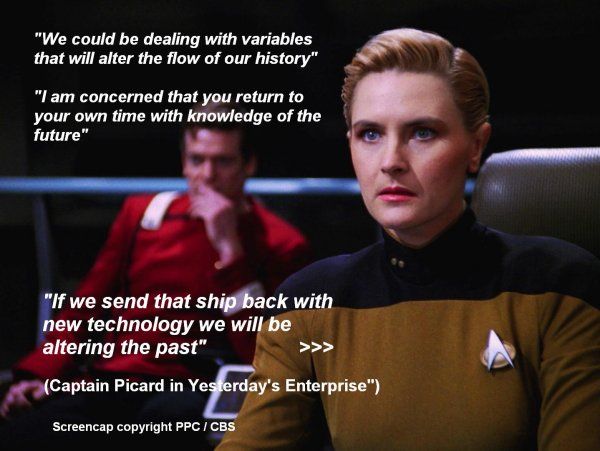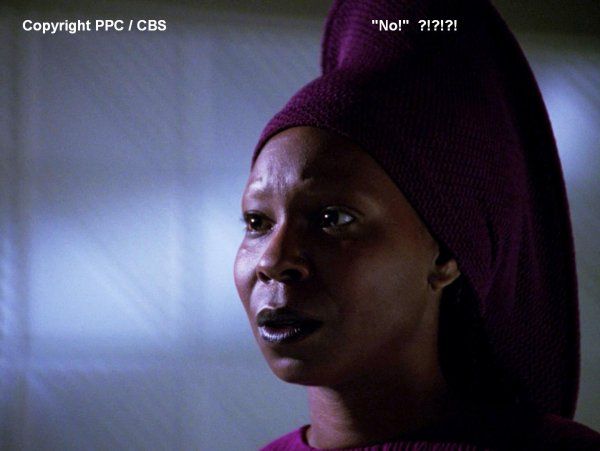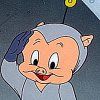Part V - Guinan and the Wrath of Q?
After the observations featured in Part IV, I would usually think that it shouldn’t be necessary to still play the “Q Card”. But what I tried to accomplish here was also to present alternate interpretations and matters of perspective (which ironically and, of course, entirely coincidental is the name of the episode separating “Déjà Q” from “Yesterday’s Enterprise”) and these would not be complete without the Q interpretation for a couple of good reasons.
Guinan and her species remain a mystery. The “universe at war” Data speculates
“Perhaps her species has a perception that goes beyond linear time.” Regardless whether we are dealing with an alternate time or an alternate universe, what we can observe is that Guinan must share some connection with her “counterparts” in the alternate reality, even if that exists only on an unconscious level to which she apparently has access to the point enabling her to draw clear conclusions.
Tapping into some kind of collective consciousness and experience would undoubtedly make her a hell of a counseling bartender which she undoubtedly is (to quote Dr. Boyce from “The Cage”:
“Sometimes a man'll tell his bartender things he'll never tell his doctor”).
For all we know that might have been the reason why the Q got interested in her, because according to “Q Who” there must have been interaction with her and other Q
(“Some are almost respectable”). It’s obvious that Q and she don’t get along.
Guinan does have Q-like-powers and apparently she can sense his presence
(“I knew it was you”) and realize when he is up to no good
(“Q!”).
In “Déjà Q” her relationship took a drastic turn. Stating that he had been deprived of his Q powers Guinan instantly tested his claim
by suddenly stabbing the hand of the (previously) omnipotent Q with a fork who cried out in pain and agony.
Would the almighty Q, after he had regained his godlike powers, let this frivolous and vicious assault go unanswered? 
The other party which had assaulted Q in this episode was the Calamarain and near the end of the episode we saw that he was about to retaliate
(“If you think I tormented you in the past, my little friends, wait until you see what I do with you now”) but the other Q interfered. Undoubtedly Q was elaborating on some kind of payback for Guinan, but one the other Qs would be okay with (“almost respectable” didn’t sound as if Guinan had any “Quardian Angels”).
Is “Yesterday’s Enterprise” the sequel to “Déjà Q”?
“Yesterday’s Enterprise” features a couple of moments that look like these could suggest Q pulling the strings behind the events in this episode
- Guinan looked at the phenomenon and says “No!” Her reaction suggested that she “knew” that nothing good was about to be happening next (just as her “Q!” reacting to Q’s “We'll just have to see how ready you are.” in “Q Who”)
- Captain Garrett of the Enterprise-C reported that the last thing she remembered was “a bright light, and then here”. A bright light indicating a sudden change of the environment happened to be one of Q’s trademarks.
- At the end of (what would have been the shortest TNG episode had events in “our” TNG reality been edited together) Guinan calls the bridge and asks “Captain, this is Guinan. Is everything all right up there?” Interestingly, the last time she called the bridge with the exact same words “Is everything all right?” was in “Q Who”, moments before Picard and Q materialized in Ten Forward.
While this may seem as if I were reading too much into small things, a look at Larry Nemecek’s
Star Trek TNG Companion (page 114) commenting on the early draft for “Déjà Q” reveals that this isn’t the case:
“The script originally told the story of a looming Klingon-Federation war that was actually caused by Q, who faked his loss of powers and then later rushed in to become a hero.”
The entire background setting of “Yesterday’s Enterprise” (two episodes later!) is a
Klingon-Federation war, so it stands to reason that fragments and Q elements from that early draft found their way into the teleplay,
“written by committee and rushed to final draft in just three days” and eventually ended up in “Yesterday’s Enterprise”.
Indeed, given the implausibility of a Klingon-Federation war with the Klingons emerging as the winning side (especially after ST VI), the whole “universe at war” alternate reality could have been a stage deliberately created by Q and decorated with requisites from various realities.
Q has shown to have a soft spot for dressing in costumes and creating weird environments (e.g. “Hide and Q”). His stage setting in the first season episode was obvious for the participants (and the viewing audience) to understand it wasn’t real. But for somebody probably as advanced as Guinan’s species the stage setting was somewhat more elaborate, but more difficult for viewing audiences to decide whether it’s real or fake, although the episode – as I’ve tried to show in the previous parts of this treatise – is plastered with inconsistencies which would beg for many explanations, assuming everything we see is the “real” thing:
- The strength of the Klingon Empire which apparently defeated the Romulans, first, and next turned onto the Federation. Unlikely.
- While the “universe at war” protagonists must have experienced 20 years of battle duty (opposite to our protagonists exploring the galaxy), they still exhibit the exact same personality traits as their counterparts in the “real” universe which is rather unlikely, too. The fact that even Picard is incapable of making up his mind whether they are restoring or changing the past looks like a joke.
- The appearance of the Enterprise-C which doesn’t match the one on the sculpture wall of the conference lounge of the Enterprise-D. The TMP hand phasers, apparently state-of-the-art technology in 2344, look hopelessly outdated.
- The whole notion that you could travel to the past and unchange what happened. In Part II of this treatise I had already hinted that we might be dealing with Q when I wrote “The sudden transformation of solid materials, Tasha Yarn’s return from the dead, a completely new history with 22 years of events preceding the episode (unless the protagonists’ memories were implanted), it’s brief and short-lived existence in spacetime (apparently ending the moment the Enterprise-C had returned to its time) would imply the existence of some cosmological mechanism with some form of awareness capable of intelligent design which is usually attributed to our definition of God or an omnipotent being like Q.”
(Insofar I’d like to alter my response to an earlier
post: I can’t exclude that
William of Ockham would be facepalming reading what I wrote in Part II. Because - from a theologian point of view - the mere theoretical concept of going back in time and being able to alter history could have been interpreted as a valuable hint for the existence of God, then.
Possible he would be facepalming, thinking “Why didn’t I think of that?”
)
In “Yesterday’s Enterprise” the other Guinan is the lead character because it’s her actions that influences the decision making (Picard, Tasha). How she “knows” what our Guinan knows remains enigmatic, but the “No” of our Guinan could indicate foreknowledge that Q was about to set something up for her (counterpart) as a challenge.
The “universe at war” could be one of worst alternate universes where Q deliberately relocated Guinan (or some part of her consciousness) with the task to persuade the “universe at war” Picard to trust her and send the ship back, but in a manner that Picard wouldn’t think she had suddenly lost her marbles. And of course, Guinan had to persuade Picard to sacrifice at least 125 survivors from the past. Not likely a scenario Guinan would have been too happy about and no telling what might have happened to her had she failed (maybe she was in one giant penalty box?).
The very end of the episode suggests she passed Q’s test but the “universe at war” sleeves of La Forge’s uniform leave an interesting element of ambiguity.
Was Guinan merely a pawn to ensure history would happen exactly as it did?
Admittedly unlikely (but from a storytelling perspective shattering and IMO worth mentioning): Q put Guinan in an alternate universe with Novikov’s Self-Consistency Principle (Part II)
intact! Thus it would have been her recommendations to send the
Enterprise-C back that actually caused the death of 40 billion people and eventually the Federation in this alternate reality!

The information we gather from the episode doesn’t contradict this interpretation:
·
“The Enterprise C was last seen near the Klingon outpost Narendra III”. This statement from the other Data apparently suggests that the Klingon outpost saw the ship and reported her presence in that sector
·
“We were responding to a distress call from the Klingon outpost on Narendra Three. The Romulans were attacking it. We engaged them, but there were four warbirds.” Captain Garrett’s report doesn’t tell us if the Klingon outpost actually received the response or even saw the
Enterprise-C defending it, which doesn’t seem to be the case, because according to the other Riker:
“There's no record of the Romulans ever assaulting the Enterprise C”.
· Worse, re-introducing the
Enterprise-C into its own time and her subsequent destruction by the Romulans gave these exactly what they otherwise couldn’t have hoped for: The wreckage of a Federation ship to make it look as if the Federation had attacked the Klingon outpost at Narendra III but perished in the subsequent mutual exchange of fire! With no survivors left and with a little meddling from the Duras family, the Klingons would have declared war on the United Federation of Planets.
And this wouldn’t be the first and only time Q put somebody between a rock and a hard place – because he would do the exact same thing again later at the end of TNG with Captain Picard!
(“There you go again, always blaming me for everything. Well this time I'm not your enemy. I'm not the one that causes the annihilation of mankind. You are.”)
Of course, the ending of “Yesterday’s Enterprise” suggests otherwise as did the “Love Conquers All” version of “
Brazil” to appeal to audiences expecting a happy ending.
Alright, as far as I am aware of, none of the production notes suggests these interpretations and this has apparently been the essential criticism of those that object this treatise.
However, if we accepted the possible in-universe conclusions from this episode (in combination with “Redemption, Part II”) at face value, we’d have to conjure up rationalizations like Tasha Yar
au naturel and/or Romulan warbird commanders tanked up with Romulan Ale and/or an utterly bumbling and incompetent Romulan Tal Shiar intelligence service to make it work to fill and cover up the plotholes.

I think Jonathan Frakes, in a noteworthy case of congruence with his character in this episode, summed it up concisely: "
To this day I do not understand 'Yesterday's Enterprise'. I do not know what the fu** happened in that episode. I'm still trying to understand it – but I liked the look."
Whether these production oddities I observed were last-minute deliberate changes, accidental production screw-ups or just coincidence is irrelevant for any in-universe rationalization debate here at the BBS as I have come to understand it.
Suffice to say that the visual and dialogue information provides the opportunity for alternate interpretations and I have made use of that. Whether these alternate interpretations provide a better explanation for what transpired onscreen and in this particular episode or not is up to the reader to decide.
I definitely enjoyed the experience, looking at “Yesterday’s Enterprise” from different perspectives, and I believe any truly open-minded Star Trek (TNG) fan would rather appreciate than condemn such a mental exercise.
 Summary
Summary
During TNG we have seen two different versions of the
Enterprise-C
- one is a sculptured model on the conference lounge wall of the Enterprise-D (faithfully reflecting the correct proportions and design by Andrew Probert) in our “real” TNG universe
- the other one is a VFX model (designed by Rick Sternbach, built by Greg Jein) featured exclusively (as the Enterprise-C) in the alternate reality or universe seen in “Yesterday’s Enterprise”
Given the variables and uncertainties concerning the phenomenon in space, the inconsistencies of the screenplay and the impossibility to exclude Q’s interference in all of this because of the aforementioned “Qlues”, there is no reliable and solid evidence that Sternbach’s
Enterprise-C in “Yesterday’s Enterprise” is the only one that left “our” reality and returned to it.
The one thing that is reliable evidence in our universe is the look of the
Enterprise-C designed by Andrew Probert and displayed on the conference lounge wall of the
Enterprise-D, the conference lounge of Captain Jean-Luc Picard.
And what does Captain Picard cherish above all things?
“The first duty of every Starfleet officer is to the truth. Whether it's scientific truth, or historical truth, or personal truth. It is the guiding principle upon which Starfleet is based.”
Therefore, the mere thought that Captain Picard would tolerate an inaccurate or falsified and misleading reproduction of the renowned predecessor of his Enterprise in his conference lounge, a reception place for alien guests and delicate negotiations, would reduce this principle of truth to absurdity.
I think now would be a good time to free the
Enterprise-C from her golden shell in which she had been encased for so long and take a better look at her.
Click HERE to make her fly and take a step into larger worlds
(animation courtesy of Tobias Richter & The Light Works, more still images
here)
Thanx for your attention and patience.
Bob



 )
)

 sorry Deanna – but then she would have been of no use on the bridge of the Enterprise-C).
sorry Deanna – but then she would have been of no use on the bridge of the Enterprise-C).







